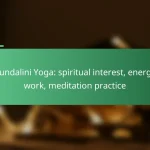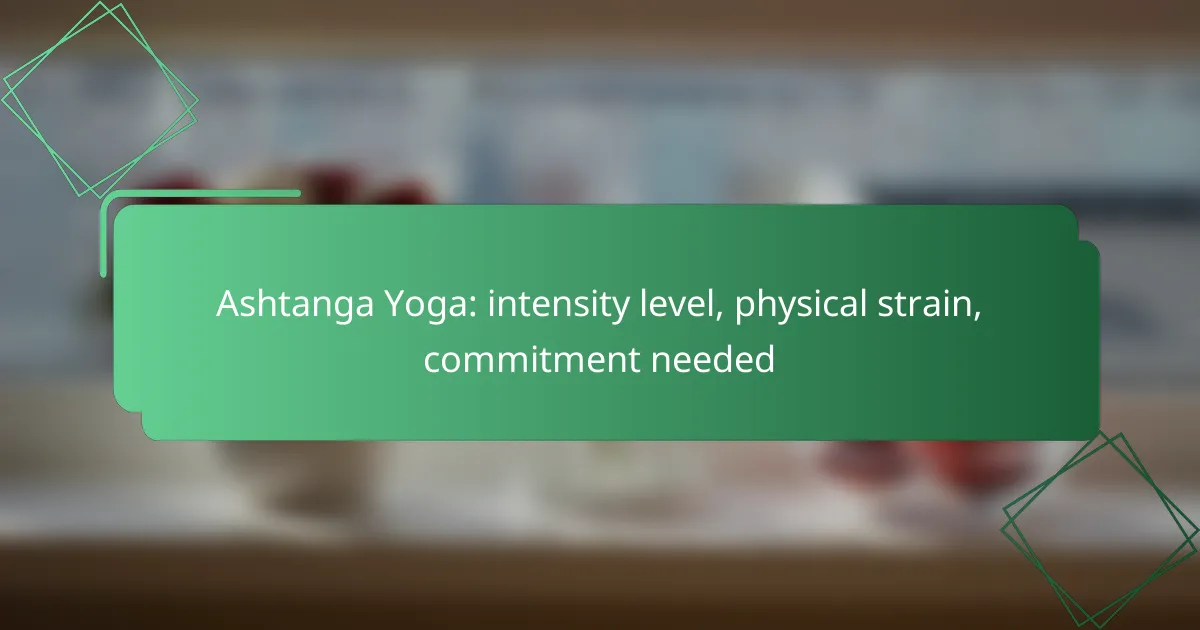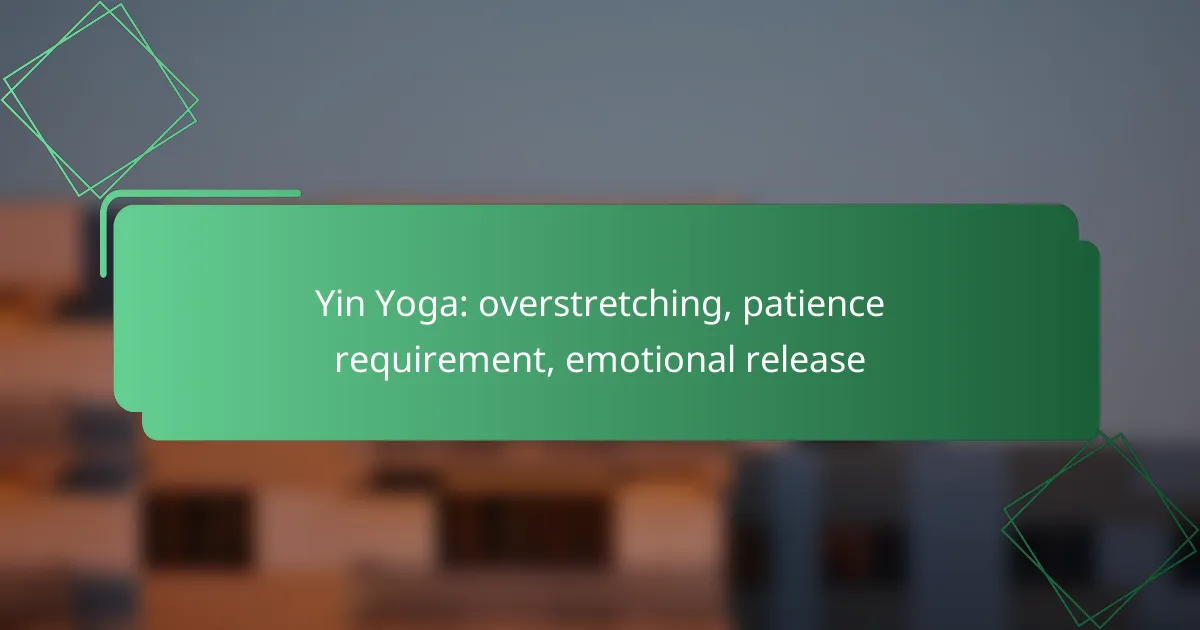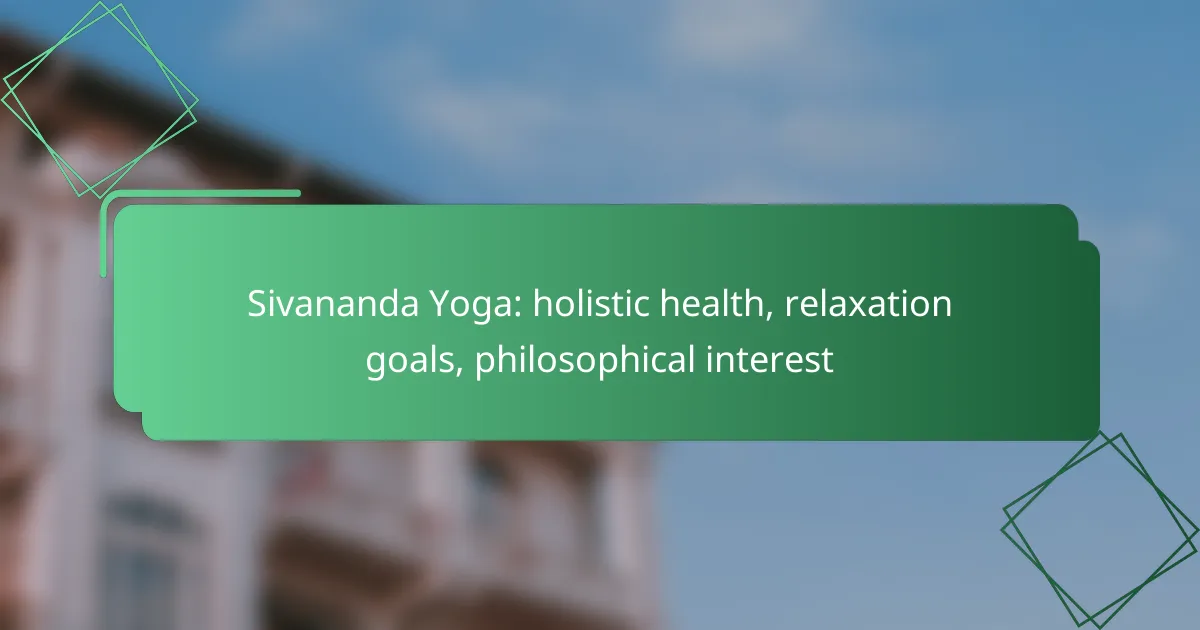Ashtanga Yoga is a dynamic and intense practice that demands significant physical effort and commitment from its practitioners. Characterized by a rigorous sequence of postures performed in a continuous flow, it requires strength, flexibility, and endurance, often leading to considerable physical strain. To fully experience the benefits of this demanding style, one must be prepared to invest time and maintain a consistent practice.

What is the intensity level of Ashtanga Yoga?
The intensity level of Ashtanga Yoga is generally high, requiring significant physical effort and commitment. This style of yoga is characterized by a rigorous sequence of postures performed in a continuous flow, which can lead to considerable physical strain and demands on the practitioner.
High-intensity practice
Ashtanga Yoga is known for its high-intensity practice, which can elevate heart rates and enhance strength and flexibility. Practitioners often experience a vigorous workout, making it suitable for those who enjoy a challenging physical routine.
It’s important to approach this intensity gradually, especially for beginners. Starting with shorter sessions and gradually increasing duration and complexity can help prevent injury and build endurance.
Dynamic sequences
The dynamic sequences in Ashtanga Yoga consist of a series of postures that flow seamlessly from one to another. This continuous movement not only builds strength but also improves cardiovascular fitness.
Each sequence is designed to engage multiple muscle groups, promoting overall body conditioning. Practitioners should focus on maintaining proper alignment and form to maximize benefits and minimize the risk of strain.
Breath synchronization
Breath synchronization is a key component of Ashtanga Yoga, where each movement is linked to an inhalation or exhalation. This practice enhances focus and helps regulate the intensity of the workout.
By coordinating breath with movement, practitioners can maintain a steady rhythm, which aids in endurance and concentration. Learning to control breath is essential for managing the physical demands of the practice.
Vinyasa flow
Vinyasa flow is a hallmark of Ashtanga Yoga, emphasizing the transition between poses in a fluid manner. This approach not only increases the intensity but also encourages mindfulness and presence during practice.
Practitioners should be aware of their limits and avoid rushing through transitions, as this can lead to improper form and potential injuries. A steady, mindful approach to Vinyasa flow can enhance both the physical and mental aspects of the practice.

What physical strain does Ashtanga Yoga involve?
Ashtanga Yoga involves significant physical strain due to its demanding sequences that require strength, flexibility, and endurance. Practitioners often experience intense muscle engagement and joint stress, making it essential to approach the practice with awareness and commitment.
Muscle engagement
Ashtanga Yoga requires substantial muscle engagement, particularly in the core, arms, and legs. Each pose is designed to build strength through dynamic movements and transitions, often leading to muscle fatigue. Regular practice can enhance muscle tone and overall strength, but it is crucial to listen to your body to avoid overexertion.
Joint flexibility
Joint flexibility is a key component of Ashtanga Yoga, as many poses demand a wide range of motion. Practitioners often work on improving their flexibility over time, which can help reduce stiffness and enhance mobility. However, pushing too hard can lead to strain, so it’s advisable to progress gradually and respect your limits.
Cardiovascular demands
The cardiovascular demands of Ashtanga Yoga are notable, especially during the faster-paced sequences. The continuous flow of movements elevates the heart rate, providing a cardio workout alongside strength training. Beginners may find it beneficial to start with slower-paced classes to build endurance before tackling more intense sessions.
Risk of injury
While Ashtanga Yoga offers numerous benefits, there is a risk of injury if poses are performed incorrectly or without adequate preparation. Common injuries include strains and sprains, particularly in the lower back, shoulders, and knees. To minimize risk, focus on proper alignment, warm up adequately, and consider working with a qualified instructor to ensure safe practice.
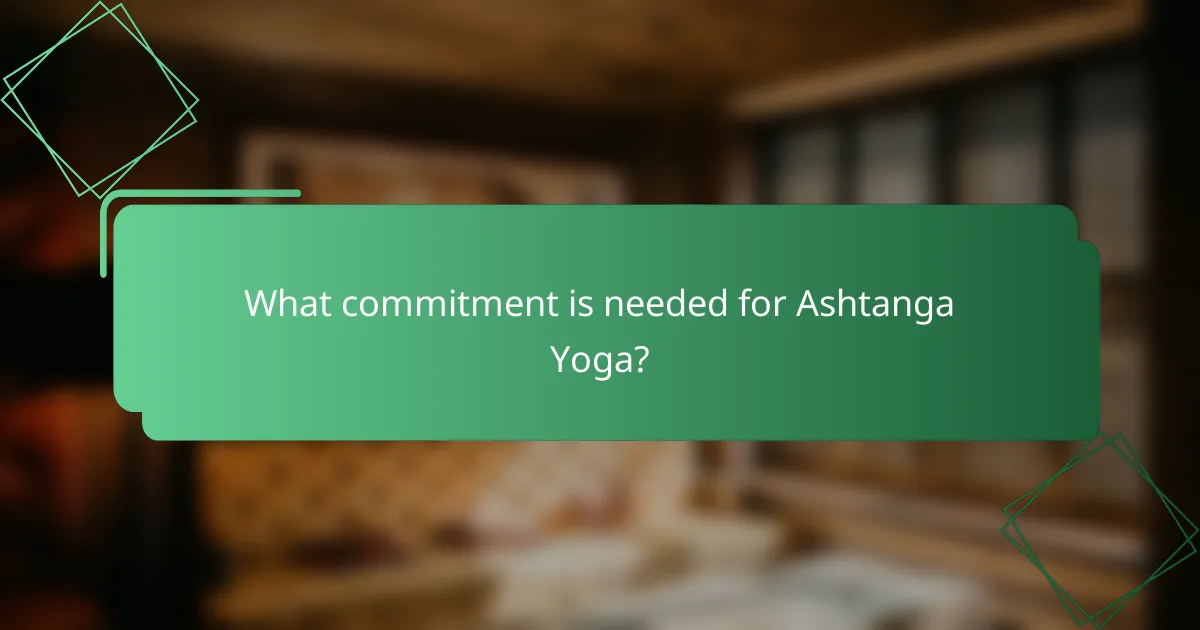
What commitment is needed for Ashtanga Yoga?
Ashtanga Yoga requires a significant commitment in terms of regular practice, mental focus, and long-term dedication. Practitioners must be prepared to invest time and energy consistently to experience the full benefits of this dynamic yoga style.
Regular practice schedule
Establishing a regular practice schedule is crucial for success in Ashtanga Yoga. Most practitioners aim for at least five to six days a week, following a set sequence of postures. Skipping days can disrupt progress and diminish the physical and mental benefits.
Consistency is key; even shorter sessions can be effective if practiced regularly. Consider starting with a manageable schedule and gradually increasing frequency as you build endurance and familiarity with the sequences.
Time investment
Each Ashtanga Yoga session typically lasts between 60 to 90 minutes, depending on the practitioner’s level and the specific series being practiced. Beginners may find shorter sessions beneficial, while more experienced yogis often engage in longer practices to deepen their experience.
In addition to the physical practice, allocating time for preparation and mindfulness can enhance the overall experience. This may include meditation or breathwork, which can add an extra 10 to 20 minutes to your routine.
Mindfulness and focus
Mindfulness and focus are essential components of Ashtanga Yoga. Practitioners are encouraged to maintain a strong connection between breath and movement, which requires concentration and mental clarity. This focus not only enhances the physical practice but also cultivates a deeper sense of awareness.
Incorporating mindfulness techniques, such as setting intentions or practicing meditation, can improve your overall experience. Aim to stay present during each session, as this will help you navigate challenges and deepen your practice.
Long-term dedication
Long-term dedication is vital for mastering Ashtanga Yoga. Progress can be gradual, and it often takes months or years to fully integrate the practice into your lifestyle. Staying committed through challenges and plateaus is essential for growth.
Joining a community or finding a teacher can provide support and motivation. Regular workshops or retreats can also enhance your understanding and commitment, helping you stay engaged with your practice over time.
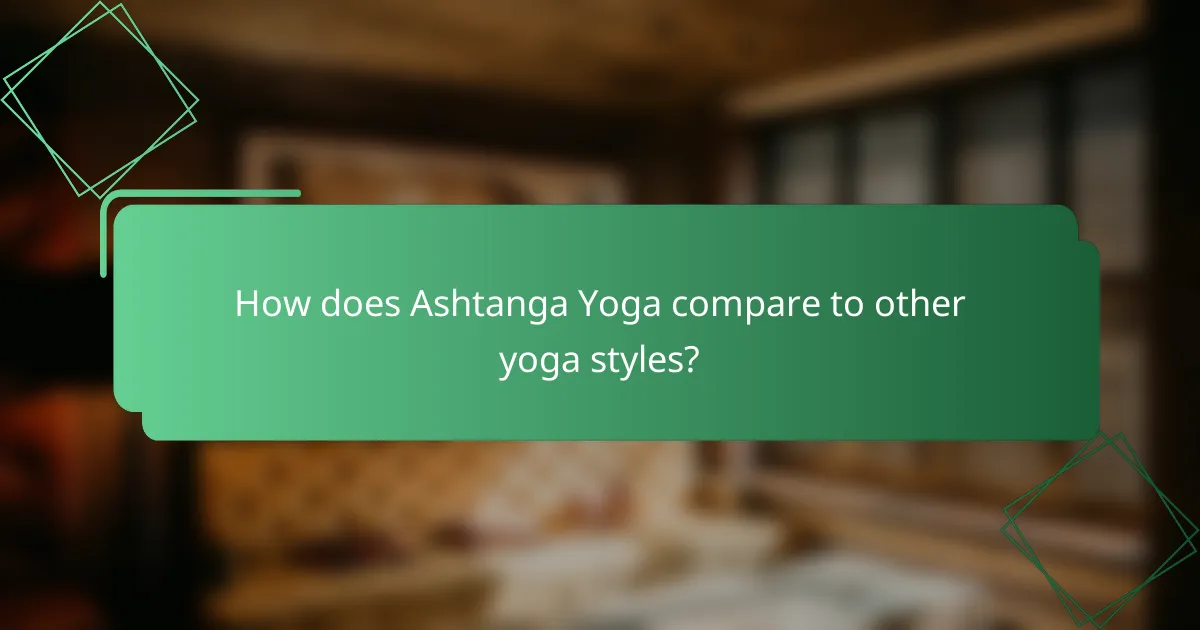
How does Ashtanga Yoga compare to other yoga styles?
Ashtanga Yoga is often seen as more intense and physically demanding compared to other yoga styles. It involves a set sequence of poses performed in a specific order, requiring significant commitment and stamina.
Ashtanga vs. Hatha Yoga
Ashtanga Yoga differs from Hatha Yoga primarily in its intensity and structure. While Hatha focuses on basic postures and is generally slower-paced, Ashtanga follows a vigorous sequence that links breath with movement, making it more physically challenging.
Practitioners of Hatha Yoga can expect a more relaxed experience, often suitable for beginners or those seeking a gentler approach. In contrast, Ashtanga demands higher levels of physical fitness and mental focus due to its rigorous flow and set sequences.
Ashtanga vs. Vinyasa Yoga
Both Ashtanga and Vinyasa Yoga emphasize breath and movement, but Ashtanga is more structured with its fixed series of postures. Vinyasa allows for more creativity and variation in sequences, making it adaptable to different fitness levels and preferences.
Ashtanga typically requires a greater commitment to mastering the specific series, while Vinyasa classes can vary widely in intensity and style, appealing to a broader audience. This flexibility in Vinyasa can make it easier for practitioners to find a class that suits their current fitness level.
Ashtanga vs. Iyengar Yoga
Ashtanga Yoga and Iyengar Yoga differ significantly in their approach to postures and alignment. Iyengar emphasizes precise alignment and often uses props to assist practitioners in achieving correct posture, making it accessible to those with injuries or limitations.
In contrast, Ashtanga focuses on fluid movement through a set sequence, which can be more physically demanding. While both styles promote strength and flexibility, Iyengar may be better suited for those who prefer a slower, more methodical practice, whereas Ashtanga appeals to those seeking a high-intensity workout.
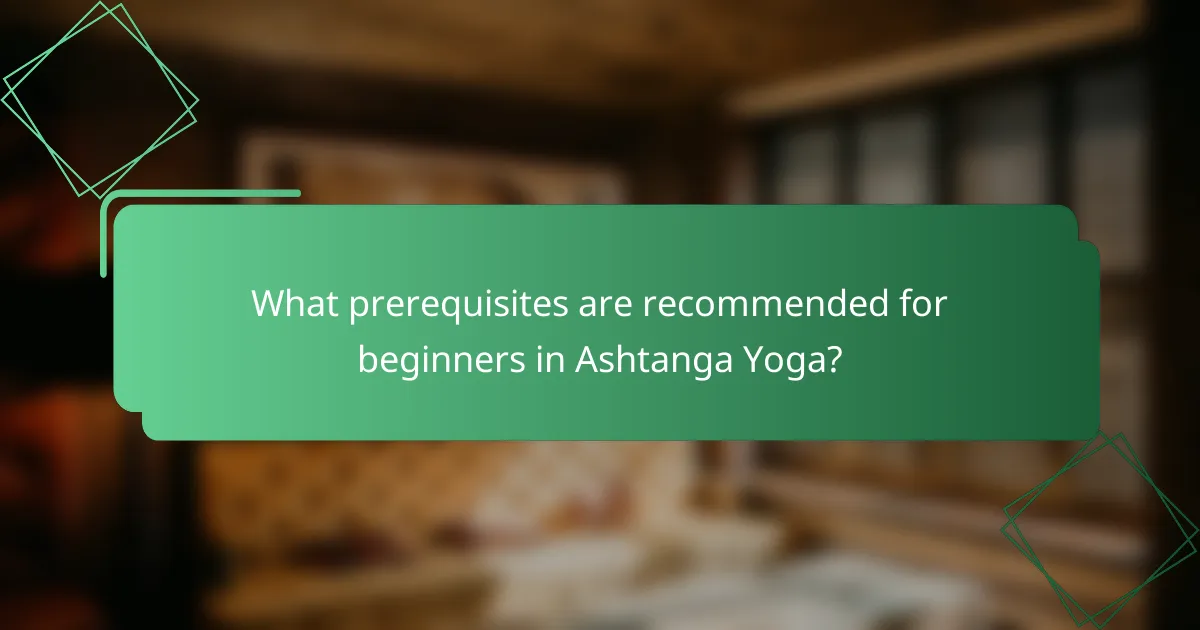
What prerequisites are recommended for beginners in Ashtanga Yoga?
Beginners in Ashtanga Yoga should ideally have a basic understanding of yoga principles, a reasonable level of physical fitness, and some familiarity with breath control techniques. These prerequisites help ensure a smoother introduction to the practice and reduce the risk of injury.
Basic yoga knowledge
Having basic yoga knowledge is essential for beginners in Ashtanga Yoga. This includes understanding fundamental poses, alignment principles, and the overall structure of a yoga class. Familiarity with common terms such as “asana” (posture) and “namaste” can enhance the learning experience.
Consider attending a few introductory classes or workshops to build this foundational knowledge. Online resources and beginner yoga books can also provide valuable insights into the practice.
Physical fitness level
A reasonable level of physical fitness is important for engaging in Ashtanga Yoga, which can be physically demanding. Beginners should assess their current fitness level and be prepared for a workout that may include strength, flexibility, and endurance components.
It’s advisable to start with a gentle yoga class if you’re new to physical activity. Gradually increasing your fitness through activities like walking, swimming, or basic strength training can also prepare you for the intensity of Ashtanga Yoga.
Understanding of breath control
Understanding breath control, or “ujjayi” breathing, is crucial in Ashtanga Yoga. This technique involves breathing deeply and audibly through the nose, which helps to focus the mind and maintain energy during practice. Beginners should practice this breathing method outside of class to become comfortable with it.
Incorporating breath awareness into your daily routine can enhance your yoga experience. Simple exercises, such as inhaling for a count of four and exhaling for a count of six, can help you develop a strong foundation in breath control before starting Ashtanga Yoga.
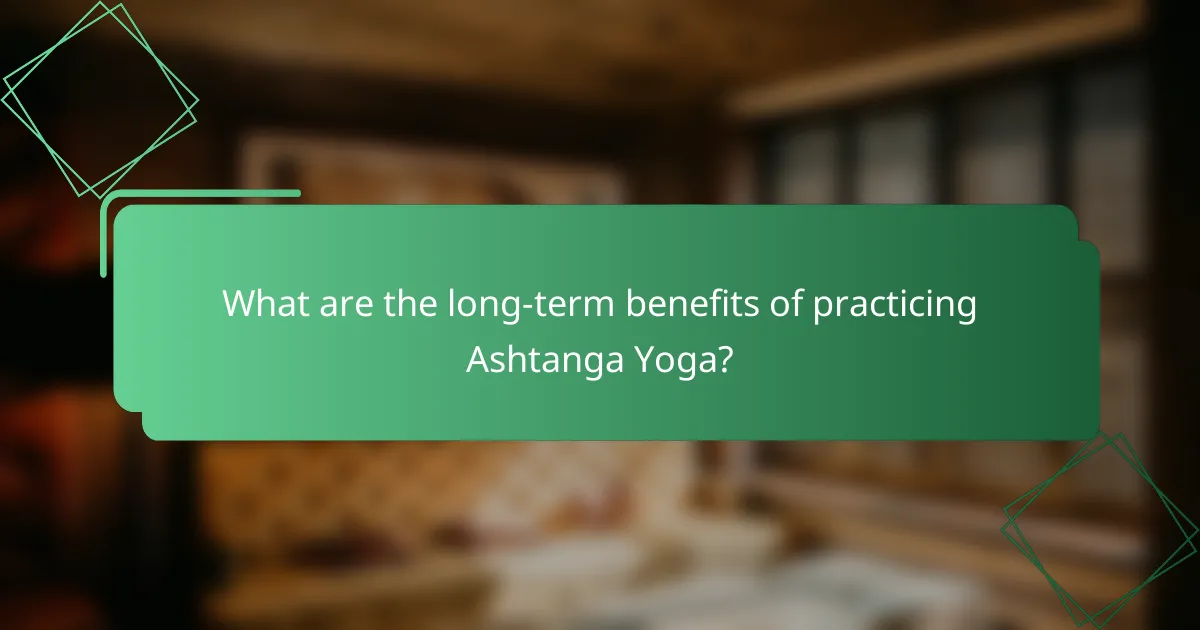
What are the long-term benefits of practicing Ashtanga Yoga?
Practicing Ashtanga Yoga offers numerous long-term benefits, including improved flexibility, strength, and mental clarity. Over time, practitioners often experience enhanced physical fitness and a deeper sense of inner peace.
Intensity Level
The intensity level of Ashtanga Yoga is generally high, as it involves a dynamic sequence of postures performed in a flowing manner. This vigorous practice can elevate heart rates and build endurance, making it suitable for those seeking a challenging workout.
Beginners may find the pace demanding, but modifications can be made to accommodate varying fitness levels. As practitioners advance, the intensity naturally increases, promoting greater physical and mental resilience.
Physical Strain
Ashtanga Yoga can place significant physical strain on the body, particularly on the muscles and joints. It’s essential to listen to your body and avoid pushing beyond your limits to prevent injuries.
Common areas of strain include the lower back, shoulders, and wrists. Incorporating proper warm-up routines and focusing on alignment can help mitigate these risks and enhance overall practice.
Commitment Needed
Commitment is crucial for reaping the long-term benefits of Ashtanga Yoga. Regular practice, ideally several times a week, is necessary to build strength and flexibility effectively.
Setting realistic goals and maintaining a consistent schedule can foster dedication. Joining a community or finding a teacher can also provide motivation and support, making it easier to stay committed to the practice.

